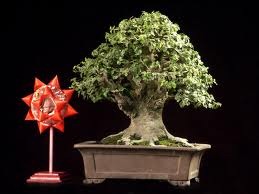 REPOTTING
REPOTTING
Repotting must be performed periodically on all bonsai when their root system has filled the pot. The reasons for repotting are to supply your tree with fresh soil, and to
encourage a more compact root system. As a rule, most deciduous trees require repotting every two or three years, while evergreens only need to be repotted every four or five years. Since trees grow at different rates, this schedule will not always hold true, therefore, you should examine your tree’s root system each year to determine if it has become pot-bound.
In most cases, the potting process is easy and safe if performed properly and at the right time of the year. Repotting should be done in mid-summer. The tree, along with all of its soil, should be removed from the pot. The
outer and bottom most fourth of the tree’s root mass should be removed. This is done by raking the soil away, then pruning back the roots. In most cases, it is not good to prune back more than one fourth of the tree’s root mass. After this, the tree can be placed back in its original pot or into another. The pot should have screen placed over the drainage holes. Then a thin layer of small gravel is placed in the bottom of the pot for drainage purposes. On top of this gravel is placed the new fresh soil. Place a layer of well-draining soil which is sufficient enough to elevate the tree to its previous height in the pot. After placing the tree back in the pot, the area left vacant by the pruned
root mass should be filled in with fresh soil. This fresh soil should be worked in around and under the root mass in such a manner as to avoid leaving any air pockets. After repotting, your bonsai should be thoroughly watered. This can be achieved by submerging the entire pot in a tub of water. Moss or other ground covers can be used to cover
the surface of the pot to help prevent soil erosion when watering.
TRAINING
Training deals with the art of bonsai and should be thoroughly understood before undertaking — or left to a professional. However, most of the true bonsai trees you find have already been through their training period, thus requiring only periodic trimming and pinching to remain miniature.
TRIMMING & PINCHING
Trimming and pinching keep your tree miniature. Pinch and trim back the new growth to the farthest safe point. Never should all of the new growth be removed. A little should be left to sustain the health of the tree. Tropical and sub-tropical trees used for bonsai will require periodic pinching and trimming throughout the year. Since different trees grow at different rates, it is necessary to
evaluate each tree’s rate of growth and adjust your trimming and pinching to accommodate it.
INSECTS & DISEASES
Since your bonsai is a tree in miniature, it can be treated for insects and diseases the same as any other tree. If you discover any insects or diseases, visit our website where you will be able to obtain the necessary products to eliminate the problem.

Deprecated: strpos(): Passing null to parameter #1 ($haystack) of type string is deprecated in /home/agriviek8Qv/agriviet.net/public_html/wp-includes/comment-template.php on line 2522